|
Tecate twin Craftsman bungalows Threatened
By Maria E Curry
May/June 2019
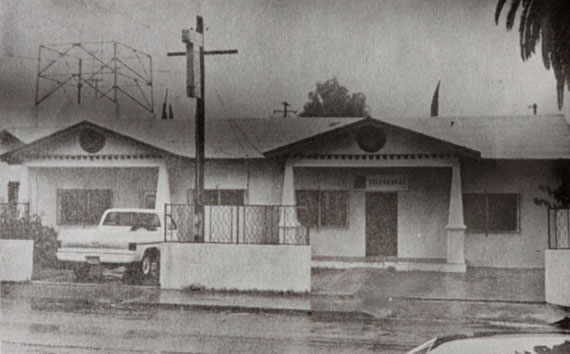 Photo from the 1985 Catálogo de Monumentos Históricos Inmuebles, Baja California. Instituto Nacional de Antropología e Historia. The two bungalows are listed on page 557 and 558 |
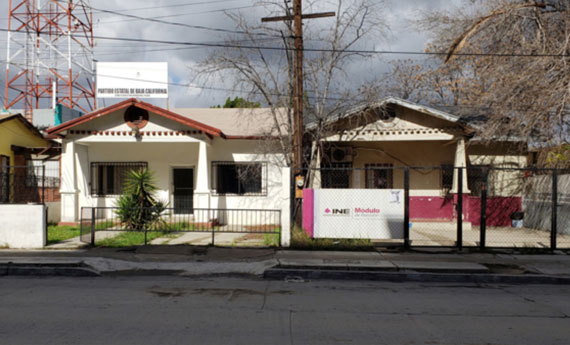 |
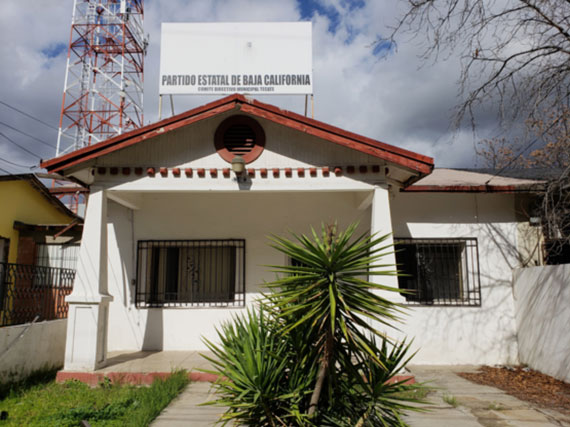 Above 2 Identical bungalows on Hidalgo Street, Tecate Baja Califronia, 2004 |
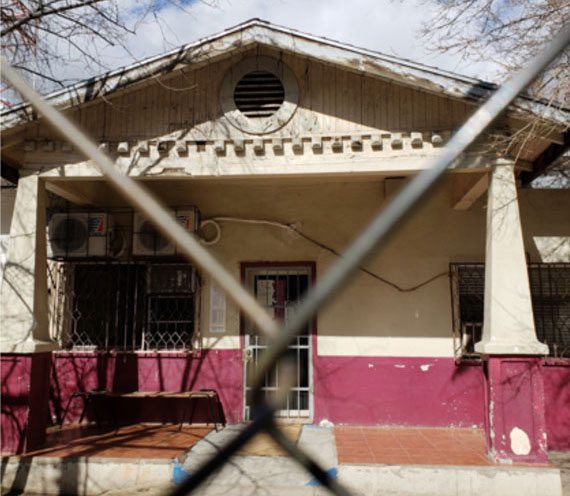 Photo of one of the bungalows, 2019 |
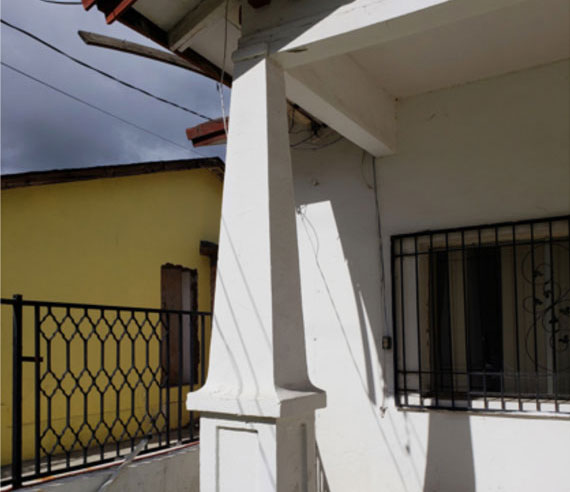 Detail of left side bungalow on Hidalgo Street, 2019. All color photos above by Maria E Curry |
Twin Craftsman bungalows in Tecate, Baja California are threatened with demolition—twice the potential loss for neighbors and preservationists. Known by residents as "las Casas Iguales" ("the Identical Houses"), they stand next to each other, deteriorating on the city's oldest street: Calle Libertad (now Calle Hidalgo), which runs parallel to the San Diego and Arizona-Tijuana-Tecate railroad tracks. These bungalows are listed as historic monuments, based on a survey, in the Catálogo de Monumentos Históricos Inmuebles de Baja California from the Instituto Nacional de Antropología e Historia (INAH) and are also deemed part of the cultural patrimony by the Instituto de Cultura de Baja California (ICBC). Being "listed" means the bungalows were surveyed and found to be important; this status, while not the same as designation in the U.S., helps to stop demolition or alterations temporarily until a legal declaration is made by a board or more research is done.
Calle Hidalgo is part of engineer Luis Pavón's original 1917 plan of Tecate. Today, Tecate is recognized as a pueblo mágico (magical town) by the federal government for its cultural values. This status strengthens the protection of its cultural heritage. The houses are privately owned, and, according to preservation advocates, the owner wants to replace them with a restaurant-bar. Guadalupe Alvarez, a student from the first border cities preservation course at the Centro de Posgrado y Estudios Sor Juana, has succeeded in delaying demolition of the bungalows by using the 1995 Baja California cultural patrimony preservation law (Ley de Preservación del Patrimonio Cultural). She is a member of Tecate's preservation commission and a recognized tourist guide. The commission has 90 days to prove the cultural value of these houses and convince the ICBC to designate them as state monuments.
Tecate, Baja California, a city bordering with Tecate in the U.S., is Kumeyaay and Pai Pai territory. Indigenous groups in the border region share their cultural traditions, including ceremonies in the sacred mountain Cuchuma that divides the two Tecates. Hidalgo Street, originally one of the trails that connected indigenous communities, united the two Californias. It also formed part of the wagon road that joined posts in California with those in Yuma, Arizona. The Butterfield Stage Line transported merchandise and passengers along this route. Tijuana and Tecate ranchos served as stops where travelers could rest and acquire goods. This street is extremely significant for its binational regional history.
In fact, people used to say that Tecate was made up of a single street that started in Tijuana and ended in Mexicali. The first houses, including these identical bungalows, were built on and around this street for the families of railroad workers and employees of various industries that developed from the 1910s to 1940s. Products included oil, malt, coffee, flour, wine, whiskey, and the famous Tecate beer. As the city grew, Hidalgo Street filled up with commercial businesses such as stores, restaurants, lodging, and the Iglesia de Nuestra Señora de Guadalupe. For a short time in the 1980s and '90s, Hildalgo Street hosted "pamplonadas," the Spanish tradition of the "running of the bulls," an attraction that attracted hundreds of tourists.
Nowadays, you can trace part of the city's history through its old houses in the Mission, Prairie, and Craftsman styles. The oldest houses were built of adobe. When the train arrived in 1914, it delivered wood and brick for construction. Also in the early 20th century, bungalows were moved from the U.S. using horses.
The two endangered bungalows are one story, with symmetrical facades: a centered front door flanked by a pair of windows. They have low-pitched, gabled roofs supported by elongated sloping columns over square piers that extend to the ground. Other Craftsman characteristics include round dormers; wide eave overhangs, and full width porches. The interiors were modified for office use.
The INAH catalogue states these dwellings were converted to federal government and telegraph offices, used from 1922 to 1952, before the municipal building was constructed on the main square. The political party Partido Estatal de Baja California and the federal electoral institute (Instituto Nacional Electoral) were the last tenants.
Today both bungalows are abandoned, and left to deteriorate as a preamble to their demolition. However, Lupita Alvarez will not allow that to happen. She is teaming up with historians to gather information to propose designation of the houses for their association with Tecate's social, political, and urban history, and as important examples of architecture and border history.
These Craftsman bungalows, which I suspect came from San Diego, retain their architectural integrity, making them eligible for designation as Baja California's cultural patrimony. The Craftsman style, so common in early 20th-century San Diego, brought new technology and readymade homes to Mexico's border cities to meet housing needs in newly created towns. These houses deserve protection so we can better understand our regional and binational history.
|
2025
2024
2023
2022
2021
2020
2019
2018
2017
2016
2015
|








